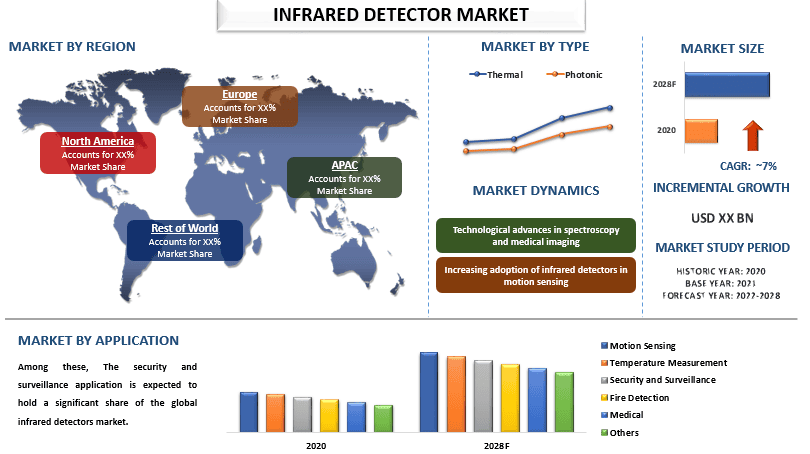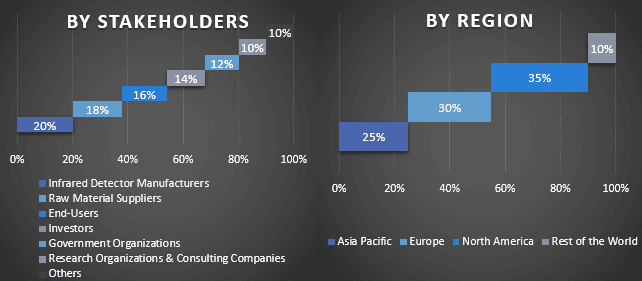- Home
- About Us
- Industry
- Services
- Reading
- Contact Us
Infrared Detector Market: Current Analysis and Forecast (2022-2028)
Emphasis on Type (Thermal and Photonic); Spectral Range (Near-wave Infrared, Short-wave Infrared, Medium-wave Infrared, and Long-wave Infrared); Technology (Cooled and Uncooled); Application (Motion Sensing, Temperature Measurement, Security and Surveillance, Fire Detection, Medical, and Others); and Region/Country

Global Infrared Detector Market is expected to grow at a significant rate of around 7% during the forecast period. The global infrared detector market is uplifting on the account of the increasing adoption of infrared detectors in motion sensing and temperature measurement applications, the rising demand for security and surveillance cameras in different industries, and the growing use of infrared detectors in manufacturing and industrial applications. Moreover, the increasing use of infrared detectors in places, such as retail shops, airports, homes, museums, and libraries for counting people and motion detection is further contributing to the growth of this market. Moreover, the increasing number of smart security camera households owing to the rising cases of burglary is further impacting the growth of the infrared detector market. For instance, in 2020, the number of smart security camera households was around 247 million which increased to more than 335 million in 2021.
Excelitas Technologies Corp., Teledyne FLIR LLC, Hamamatsu Photonics K.K., Murata Manufacturing Co. Ltd., Texas Instruments Incorporated, Omron Corporation, Raytheon Technologies Corporation, Nippon Avionics Co. Ltd., Lynred USA, and Honeywell International Inc. are some of the key players in the market. Several M&As along with partnerships have been undertaken by these players to facilitate customers with hi-tech and innovative products/technologies.
Insights Presented in the Report
“Amongst type, photonic infrared detectors to witness robust CAGR during the forecast period”
Based on type, the market is classified into thermal and photonic. The photonic infrared detectors are expected to witness a robust CAGR during the forecast period. This is due to the wide range of applications of photonic IR detectors. They are extensively used in many applications such as remote sensing, thermal imaging, environmental monitoring, and communication systems.
“Amongst spectral range, the long-wave spectral range segment to hold a significant share in the market in 2020”
Based on spectral range, the market is divided into near-wave infrared, short-wave infrared, medium-wave infrared, and long-wave infrared. The long-wave infrared held a significant share of the global infrared detector market in 2020. The ability to provide excellent detection capabilities even in low light and detect signs of heat are some of the major factors driving the growth of this segment. Light with a wavenumber of 12,500 to 4,000 cm is called near-infrared light. This wavelength is just outside the range of human vision and can sometimes provide sharper details than visible light imaging.
“North America to hold a significant share in the market”
In 2020, North America held a significant share of the global infrared detector market. This is largely due to the presence of the major infrared detector manufacturers in the region coupled with the increasing applications for surveillance and security, and motion sensing in the commercial, residential, and defense sectors are also influencing the growth of this market in the region. Moreover, the region is seeing increased demand for infrared detectors from the military and defense sector, as well as temperature measurement and industrial applications. The introduction of remote sensing technology has supplied crucial intelligence data to protection forces. Hence, the increasing budget of major space agencies is further contributing to the growth of this market in the region. For instance, in 2020, a budget of more than USD 23 billion was allocated to NASA, and this number increased to more than USD 24 Bn in 2022.
Reasons to buy this report:
- The study includes market sizing and forecasting analysis validated by authenticated key industry experts.
- The report presents a quick review of overall industry performance at one glance.
- The report covers an in-depth analysis of prominent industry peers with a primary focus on key business financials, product portfolios, expansion strategies, and recent developments.
- Detailed examination of drivers, restraints, key trends, and opportunities prevailing in the industry.
- The study comprehensively covers the market across different segments.
- Deep dive regional level analysis of the industry.
Customization Options:
The global infrared detector market can further be customized as per the requirement or any other market segment. Besides this, UMI understands that you may have your own business needs, hence feel free to connect with us to get a report that completely suits your requirements.
Table of Content
Research Methodology for the Infrared Detector Market Analysis (2022-2028)
Analyzing the historical market, estimating the current market, and forecasting the future market of the global infrared detector market were the three major steps undertaken to create and analyze the adoption of the infrared detector in major regions globally. Exhaustive secondary research was conducted to collect the historical market numbers and estimate the current market size. Secondly, to validate these insights, numerous findings and assumptions were taken into consideration. Moreover, exhaustive primary interviews were also conducted, with industry experts across the value chain of the global infrared detector market. Post assumption and validation of market numbers through primary interviews, we employed a top-down/bottom-up approach to forecasting the complete market size. Thereafter, market breakdown and data triangulation methods were adopted to estimate and analyze the market size of segments and sub-segments of the industry pertains to. Detailed methodology is explained below:
Analysis of Historical Market Size
Step 1: In-Depth Study of Secondary Sources:
Detail secondary study was conducted to obtain the historical market size of the infrared detector market through company internal sources such as annual reports & financial statements, performance presentations, press releases, etc., and external sources including journals, news & articles, government publications, competitor publications, sector reports, third-party database, and other credible publications.
Step 2: Market Segmentation:
After obtaining the historical market size of the infrared detector market, we conducted a detailed secondary analysis to gather historical market insights and share for different segments & sub-segments for major regions. Major segments are included in the report as type, spectral range, technology, and application. Further country-level analyses were conducted to evaluate the overall adoption of testing models in that region.
Step 3: Factor Analysis:
After acquiring the historical market size of different segments and sub-segments, we conducted a detailed factor analysis to estimate the current market size of the Infrared Detector market. Further, we conducted factor analysis using dependent and independent variables such as type, spectral range, technology, and application of infrared detector. A thorough analysis was conducted for demand and supply-side scenarios considering top partnerships, mergers and acquisitions, business expansion, and product launches in the infrared detector market sector across the globe.
Current Market Size Estimate & Forecast
Current Market Sizing: Based on actionable insights from the above 3 steps, we arrived at the current market size, key players in the global infrared detector market, and market shares of the segments. All the required percentage shares split, and market breakdowns were determined using the above-mentioned secondary approach and were verified through primary interviews.
Estimation & Forecasting: For market estimation and forecast, weights were assigned to different factors including drivers & trends, restraints, and opportunities available for the stakeholders. After analyzing these factors, relevant forecasting techniques i.e., the top-down/bottom-up approach were applied to arrive at the market forecast for 2027 for different segments and sub-segments across the major markets globally. The research methodology adopted to estimate the market size encompasses:
- The industry’s market size, in terms of revenue (USD) and the adoption rate of the infrared detector market across the major markets domestically
- All percentage shares, splits, and breakdowns of market segments and sub-segments
- Key players in the global infrared detector market in terms of products offered. Also, the growth strategies adopted by these players to compete in the fast-growing market
Market Size and Share Validation
Primary Research: In-depth interviews were conducted with the Key Opinion Leaders (KOLs) including Top Level Executives (CXO/VPs, Sales Head, Marketing Head, Operational Head, Regional Head, Country Head, etc.) across major regions. Primary research findings were then summarized, and statistical analysis was performed to prove the stated hypothesis. Inputs from primary research were consolidated with secondary findings, hence turning information into actionable insights.
Split of Primary Participants in Different Regions

Market Engineering
The data triangulation technique was employed to complete the overall market estimation and to arrive at precise statistical numbers for each segment and sub-segment of the global infrared detector market. data was split into several segments & sub-segments post studying various parameters and trends in the areas of type, spectral range, technology and application in the global infrared detector market.
The main objective of the Global Infrared Detector Market Study
The current & future market trends of the global infrared detector market were pinpointed in the study. Investors can gain strategic insights to base their discretion for investments on the qualitative and quantitative analysis performed in the study. Current and future market trends determined the overall attractiveness of the market at a regional level, providing a platform for the industrial participant to exploit the untapped market to benefit from a first-mover advantage. Other quantitative goals of the studies include:
- Analyze the current and forecast market size of the infrared detector market in terms of value (USD). Also, analyze the current and forecast market size of different segments and sub-segments
- Segments in the study include areas of type, spectral range, technology, and application
- Define and analysis of the regulatory framework for the infrared detector industry
- Analyze the value chain involved with the presence of various intermediaries, along with analyzing customer and competitor behaviors of the industry
- Analyze the current and forecast market size of the infrared detector market for the major region
- Major countries of regions studied in the report include Asia Pacific, Europe, North America, and the Rest of the World
- Company profiles of the infrared detector market and the growth strategies adopted by the market players to sustain in the fast-growing market
- Deep dive regional level analysis of the industry
Related Reports
Customers who bought this item also bought










